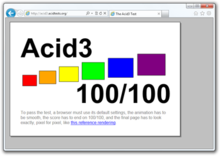Internet Explorer 9 facts,
The Internet Explorer 9 (abbreviated as IE9) is the upcoming version of the Internet Explorer web browser from Microsoft. It is currently available as a public beta version, released on September 15, 2010.
IE9 will have complete or nearly complete support for all CSS 3 selectors, border-radius CSS 3 property, faster JavaScript, and embedded ICC v2 or v4 color profiles support via Windows Color System. IE9 will feature hardware-accelerated graphics rendering using Direct2D, hardware accelerated text rendering using DirectWrite, hardware accelerated video rendering using Media Foundation, imaging support provided by Windows Imaging Component, and high fidelity printing powered by the XPS print pipeline.
IE9 also supports the HTML5 video and audio tags and the Web Open Font Format. Some industry experts claim that Microsoft will release IE9 as a major out-of-band version that is not tied to any particular version of Windows.
The system requirements for IE9 are Windows 7 or Windows Vista SP2 (with Platform Update and IE8); Windows XP is not supported.
Release history
| Color | Meaning |
|---|---|
| Red | Old release |
| Green | Current release |
| Blue | Future release |
Development

Internet Explorer 9 Beta displaying Acid3
Development of IE9 began shortly after IE8 had been released. Microsoft began taking features suggestions through Microsoft Connect soon after IE8 was released. So far, the IE team is focused on improving support for HTML5 and adding support for SVG and XHTML.
Microsoft first announced IE9 at PDC 2009 and spoke mainly about how it takes advantage of hardware acceleration in DirectX to improve the performance of web applications and improve the quality of web typography.
Later, Microsoft announced that they had joined the W3C's SVG Working Group, which sparked speculation that IE9 will support the SVG W3C recommendation. This was proven to be true at MIX 10, where they demonstrated support for basic SVG markup and improved support for HTML5. They also announced that they will increase the support greatly by the time the first IE9 beta is released. The IE team also introduced the new JScript engine for IE9, codenamed Chakra, which compiles JScript code to native code.
At MIX 10, the first IE9 Platform Preview was released, which featured support for CSS3 and SVG, a new JScript engine called Chakra, and a score of 55/100 on the Acid3 test, up from 20/100 for IE8. On May 5, 2010, the second IE9 Platform Preview was released, which featured a score of 68/100 on the Acid3 test and faster performance on the WebKit SunSpider JavaScript benchmark than the first IE9 Platform Preview. On June 23, 2010, the third IE9 Platform Preview was released, which featured a score of 83/100 on the Acid3 test and a faster JScript engine than the second IE9 Platform Preview. The third IE9 Platform Preview also includes support for HTML5 audio, video, and canvas tags, and WOFF. On August 4, 2010, the fourth IE9 Platform Preview was released, which features a score of 95/100 on the Acid3 test and a faster JScript engine than the third IE9 Platform Preview.
These previews are not full builds of IE9, as they are for testing the latest version of the Trident layout engine. They are for web developers to send feedback on the improvements made, function in parallel with any other installed browsers, and are previews of the renderer technology only, containing minimalistic user interfaces and lacking traditional chrome elements such as an address bar and navigation buttons.Microsoft updated these previews approximately every eight weeks.
On September 15, 2010, the IE9 Public Beta was released, which features a new user interface.
Improvements on previous versions
User Interface
IE9 features multiple improvements and features in its user interface. These include a trim, clean, streamlined design, improved integration with Windows 7's taskbar providing Pinned Sites, a new security-enabled download manager that manages your file transfers and informs you if a file may be malicious; address bar search, enhanced tabs and tab page, and an Add-on Performance Advisor that shows you which 3rd party add-ons may be slowing down your browser performance and then allows you to disable or remove them.
Scripting
JScript engine
IE9 features a faster (than IE8's) JScript engine, internally known as Chakra.
Chakra has a separate background thread for compiling JavaScript. Windows runs that thread in parallel on a separate core when one is available. Compiling in the background enables users to keep interacting with webpages while IE9 generates even faster code. By running separately in the background, this process can take advantage of modern multi-core machines.
In preliminary SunSpider benchmarks for the third IE9 Platform Preview, it outperformed the IE8 engine by a factor 10 and also outperformed the newest Firefox 4.0 pre-release.
ECMAScript
See also: Comparison of layout engines (ECMAScript)
The Chakra JScript engine significantly improves support for ECMA-262: ECMAScript Language Specification standard, including features new to the recently finalized Fifth Edition of ECMA-262 (often abbreviated ES5).
DOM
Document Object Model
See also: Comparison of layout engines (Document Object Model)
DOM improvements include:
DOM Traversal and Range
Full DOM L2 and L3 events
getComputedStyle from DOM Style
DOMContentLoaded
CSS
Cascading Style Sheets
See also: Comparison of layout engines (Cascading Style Sheets)
CSS improvements include support for portions of the following modules:
CSS3 Backgrounds and Borders
CSS3 Values and Units
CSS3 Media Queries
HTML5
HTML5 Media
Main article: Comparison of layout engines (HTML5 Media)
IE9 includes support for the HTML5 video and audio tags.
The audio tag will include native support for the MP3 and AAC codecs, while the video tag will natively support H.264/AVC. Support for WebM video will require third-party plugins.
[edit]HTML5 Canvas
Main article: Comparison of layout engines (HTML5 Canvas)
IE9 includes support for the HTML5 canvas tag.
HTML5 Inline SVG support
Main article: Comparison of layout engines (Scalable Vector Graphics)
The first IE9 Platform Preview has support for:
Methods of embedding: inline HTML, inline XHTML,




No comments:
Post a Comment